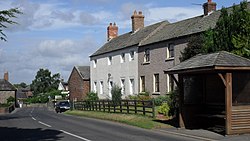Burgh by Sands
| Burgh by Sands | |
| Cumberland | |
|---|---|
 Burgh by Sands | |
| Location | |
| Grid reference: | NY32545911 |
| Location: | 54°55’19"N, 3°3’15"W |
| Data | |
| Population: | 3,709 (2011) |
| Local Government | |
| Council: | Cumberland |
Burgh by Sands (pronounced Bruff) is a village in the north of Cumberland, standing beside the Solway Firth. The parish includes the village of Burgh by Sands along with Longburgh, Dykesfield, Boustead Hill, Moorhouse and Thurstonfield.
The village is about seven miles west of Carlisle city centre. It is a little place today, with a primary school, a pub, a motor garage and a post office. It also conceals though a Roman fort at the western end of Hadrian's Wall and a statue of Edward I, who died here on campaign.
Burgh was on the Carlisle Navigation canal from 1823 to 1853,[1] after which it was served by the Port Carlisle railway, built on the bed of the canal, until its closure in 1932. From 1856 to 1964, railway trains operating on the Carlisle to Silloth line once again stopped at Burgh-by-sands station.
Name
The name 'Burgh' is "doubtless so named from the 'burh' or fort on Hadrian's Wall which ended here." [2] 'Burh' is Old English for 'fortified place'.
Church
The Church of St Michael[3] is built with stone from the Roman wall on the site of a Norman church.
St Michael's today has a broad tower with a base dating from the mid 14th Century, and apart from the 18th century east windows, the rest is Early English. The tower, which can only be reached from within the church, is designed for defence and the ground floor is tunnel-vaulted. The top of the tower is probably 18th century.
History

Hadrian's Wall runs through the village, and the site once was that of a Roman fort, Aballava. It has also been mooted as a possible site for the mythical Avalon where legend tells that King Arthur died and his sword Excalibur was forged. (If truth be told, if it can be of myth, abal or afal means "apple" and so might allow any number of places to claim that most romantic of legends.)
In the 12th century, the castle and lands of Burgh upon Sands belonged to a female-dominated line of feudal lords, among them Ada de Engaine. Her granddaughter's second marriage founded a younger branch of the de Multon family, a branch which held this castle in the 13th century. The Dacre lords inherited it in the 14th century via an heiress, their foremother.
Edward I
Edward I, while on his way to war in Scotland, died on the marshes near Burgh, and his corpse lay at the village's 12th-century church until its eventual removal to Westminster Abbey. There is an impressive monument on the marshes erected in 1685 to mark the place where he died. It is a miel and a quarter north of the village, is signposted and can be reached on foot.

Outside links
| ("Wikimedia Commons" has material about Burgh by Sands) |
References
- ↑ David Ramshaw The Carlisle Navigation Canal P3 publications 1997 ISBN 0-9522098-5-3
- ↑ Armstrong, A. M.; Mawer, A.; Stenton, F. M.; Dickens, B. (1950). The place-names of Cumberland. English Place-Name Society, vol.xx. Part 1. Cambridge: Cambridge University Press. p. 127.
- ↑ Pevsner N, Buildings of England; Cumberland and Westmorland ISBN 0-14-071033-7